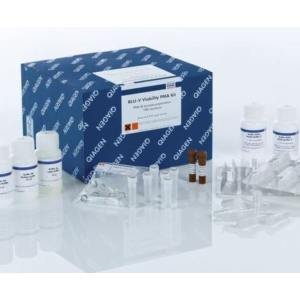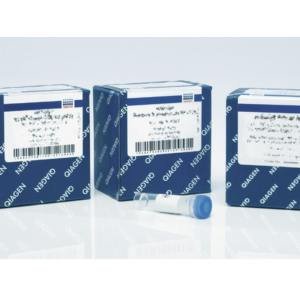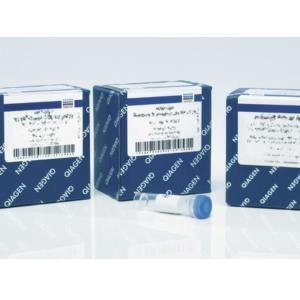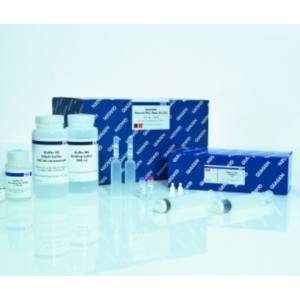Alexa Fluor® 488 Annexin V/Dead Cell Apoptosis Kit
实验概要
Apoptosis is a carefully regulated process of cell death that occurs as a normal part of development. Inappropriately regulated apoptosis is implicated in disease states, such as Alzheimer’s disease and cancer. Apoptosis is distinguished from necrosis, or accidental cell death, by characteristic morphological and biochemical changes, including compaction and fragmentation of the nuclear chromatin, shrinkage of the cytoplasm, and loss of membrane asymmetry. In normal live cells, phosphatidyl serine (PS) is located on the cytoplasmic surface of the cell membrane. However, in apoptotic cells, PS is translocated from the inner to the outer leaflet of the plasma membrane, thus exposing PS to the external cellular environment. In leukocyte apoptosis, PS on the outer surface of the cell marks the cell for recognition and phagocytosis by macrophages. The human anticoagulant, annexin V, is a 35–36 kDa Ca2 -dependent phospholipid-binding protein that has a high affinity for PS. Annexin V labeled with a fluorophore or biotin can identify apoptotic cells by binding to PS exposed on the outer leaflet.
The Alexa Fluor® 488 annexin V/Dead Cell Apoptosis Kit with Alexa® Fluor 488 annexin V and PI for flow cytometry provides a rapid and convenient assay for apoptosis. The kit contains recombinant annexin V conjugated to one of our best and brightest fluorophores, the Alexa Fluor® 488 dye, to provide the maximum sensitivity. Alexa Fluor® 488 dye is an almost perfect spectral match to fluorescein (FITC), but it creates brighter and more photostable conjugates.
In addition, the kit includes a ready-to-use solution of the red-fluorescent propidium iodide (PI) nucleic acid binding dye. PI is impermeant to live cells and apoptotic cells, but stains dead cells with red fluorescence, binding tightly to the nucleic acids in the cell. After staining a cell population with Alexa Fluor® 488 annexin V and PI in the provided binding buffer,apoptotic cells show green fluorescence, dead cells show red and green fluorescence, and live cells show little or no fluorescence. These populations can easily be distinguished using a flow cytometer with the 488 nm line of an argon-ion laser for excitation.
We have optimized this assay using Jurkat cells, a human T-cell leukemia clone, treated with camptothecin to induce apoptosis. Some modifications may be required for use with other cell types. Because no single parameter defines apoptosis in all systems, we strongly suggest using a combination of different measurements for reliable detection of apoptosis.
主要试剂
Contents and storage information.
Material | Amount | Composition | Storage* | Stability |
Alexa Fluor® 488 annexin V (Component A) | 250 µL | Solution in 25 mM HEPES, 140 mM NaCl, 1 mM EDTA, pH 7.4, 0.1% bovine serum albumin (BSA) |
| When stored as directed, kit |
Propidium iodide (PI, Component B) | 100 µL | 1 mg/mL (1.5 mM) solution in deionized water |
| When stored as directed, kit |
5X annexin-binding buffer (Component C) | 15 mL | 50 mM HEPES, 700 mM NaCl, 12.5 mM CaCl2, pH 7.4 |
| When stored as directed, kit |
*The Alexa Fluor® 488 annexin V and propidium iodide are light sensitive and may be handled in normal room light, but avoid prolonged exposure to light.
Number of assays: Sufficient material is supplied for 50 flow cytometry assays based on a 100 μL assay volume.
Approximate fluorescence excitation/emission maxima: Alexa Fluor® 488 annexin V: 488/499 in nm; Propidium iodide: 535/617 in nm, bound to DNA. Materials Required but Not Provided
Samples (appropriate sample concentrations range from 2 × 105 to 1 × 106 cells/mL)
Inducing agent
Phosphate buffered saline (PBS)
Deionized water
Caution
Propidium iodide is a potential mutagen; use appropriate precautions when handling this reagent.
实验步骤
1. Flow Cytometry Protocol
1) Induce apoptosis in cells using the desired method. Prepare a negative control by incubating cells in the absence of inducing agent.
2) Harvest the cells after the incubation period and wash in cold phosphate-buffered saline (PBS).
3) Prepare 1X annexin-binding buffer. For example, for ~10 assays, add 1 mL 5X annexin binding buffer (Component C) to 4 mL deionized water.
4) Prepare a 100 µg/mL working solution of PI by diluting 5 µL of the 1 mg/mL PI stock solution (Component B in 45 µL 1X annexin-binding buffer. Store the unused portion of this working solution for future experiments.
5) Re-centrifuge the washed cells (from step 2), discard the supernatant and resuspend the cells in 1X annexin-binding buffer. Determine the cell density and dilute in 1X annexin-binding buffer to ~1 × 106 cells/mL, preparing a sufficient volume to have 100 µL per assay.
6) Add 5 µL Alexa Fluor® 488 annexin V (Component A) and 1 µL 100 µg/mL PI working solution (prepared in step 4) to each 100 µL of cell suspension
7) Incubate the cells at room temperature for 15 minutes.
8) After the incubation period, add 400 µL 1X annexin-binding buffer, mix gently and keep the samples on ice.
9) As soon as possible, analyze the stained cells by flow cytometry, measuring the fluorescence emission at 530 nm (e.g., FL1) and >575 nm (e.g., FL3).
The population should separate into three groups: live cells show only a low level of fluorescence, apoptotic cells show green fluorescence, and dead cells show both red and green fluorescence. Confirm the flow cytometry results by viewing the cells under a fluorescence microscope, using filters appropriate for fluorescein (FITC) and tetramethylrhodamine (TRITC) or Texas Red® dye.
2. Imaging Microscopy Protocol
This protocol was developed using Jurkat cells treated with camptothecin to induce apoptosis and may be adapted for adherent cell lines.
1) Induce apoptosis in cells using the desired method. Prepare a negative control by incubating cells in the absence of the inducing agent.
2) After the incubation period, wash the cells in cold PBS.
3) Prepare 1X annexin-binding buffer. For example, to make 1 mL 1X buffer, add 200 µL 5X annexin-binding buffer (Component C) to 800 µL deionized water.
4) Prepare a 100 µg/mL working solution of PI by diluting 5 µL 1 mg/mL PI stock solution (Component B) in 45 µL 1X annexin-binding buffer. Store the unused portion of this working solution saved for future experiments.
5) Re-centrifuge the washed cells (from step 2), discard the supernatant and resuspend the cells in 1X annexin-binding buffer. Determine the cell density and dilute in annexin-binding buffer to ~1 × 106 cells/mL, preparing a sufficient volume for deposition on a slide.
6) Add 5–25 µL of the annexin V conjugate (Component A) and 1–2 µL of the 100 µg/mL PI working solution (prepared in step 4) to each 100 µL of cell suspension. Higher concentrations of the annexin V conjugate tend to produce better results; the optimal staining concentration needs to be determined empirically.
7) Incubate the cells at room temperature for 15 minutes.
8) Wash the cells with 1X Annexin-Binding buffer.
9) Deposit the cells onto slides, mount them using the desired method and observe the fluorescence using appropriate filters.
The cells should separate into three groups: live, apoptotic, and dead. Live cells show only weak annexin V staining of the cellular membrane, while apoptotic cells show a significantly higher degree of surface labeling. Dead cells show both membrane staining by annexin V and strong nuclear staining from the propidium iodide.




















